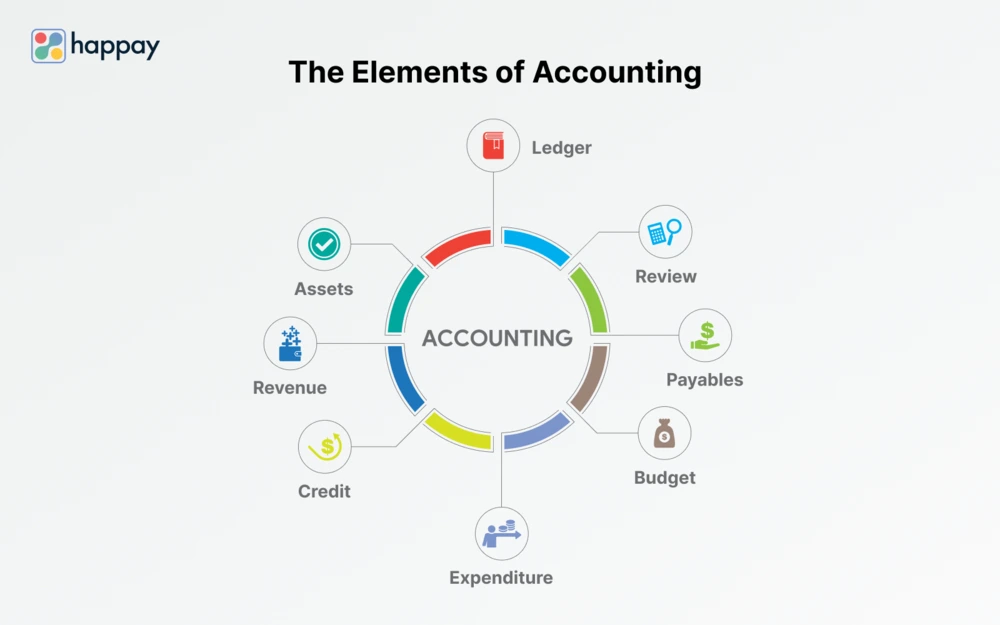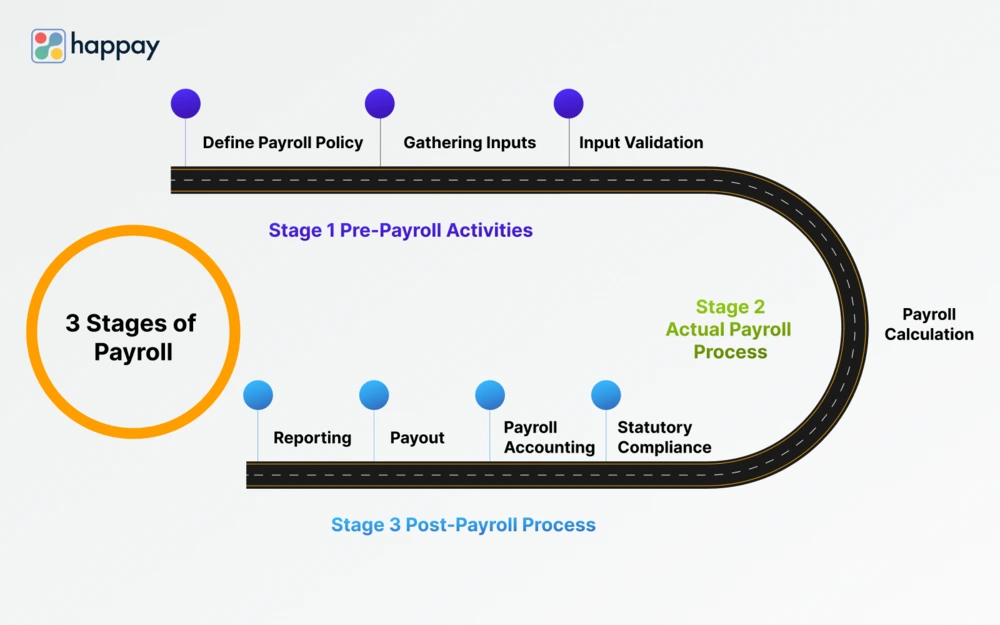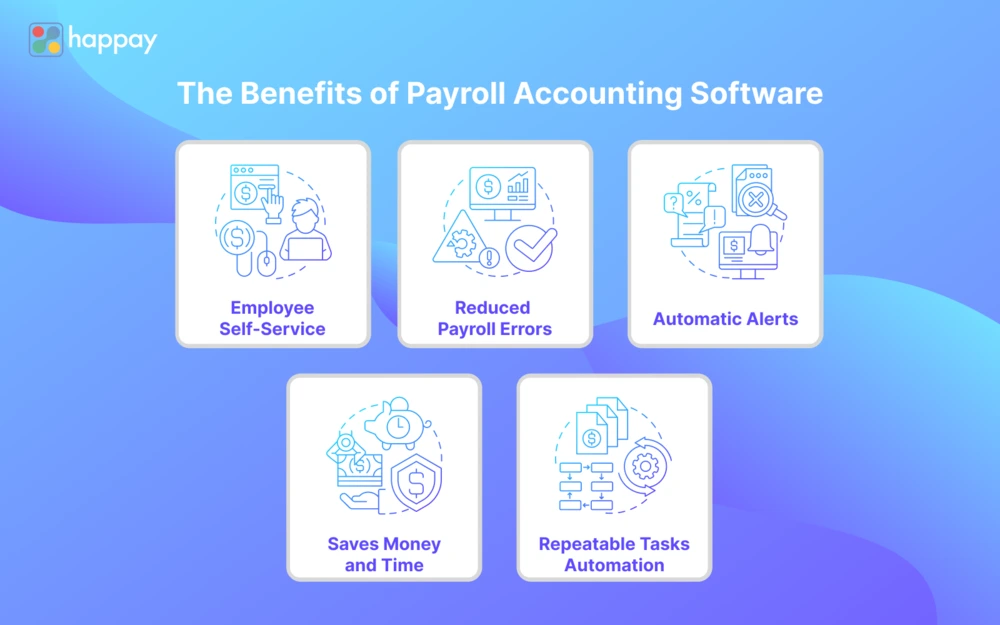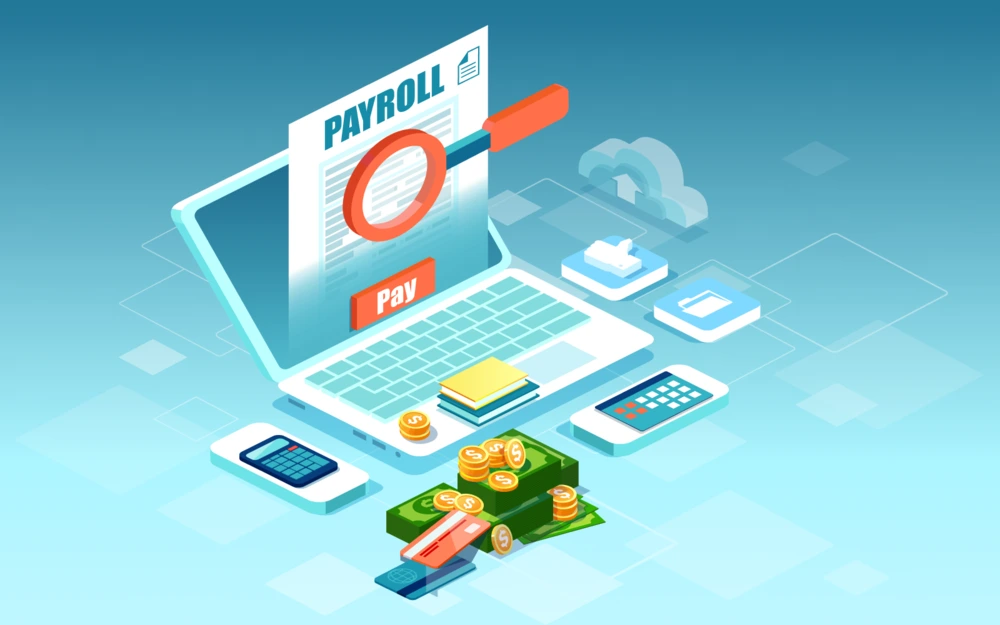Last Updated on November 28, 2025
Understanding payroll accounting
Employee paycheck delays and inaccuracies often mar the payday experience. Per a recent TalentPro India survey, 37% of payroll errors occur due to inaccurate data entry. A systematized payroll accounting system is thereby essential to a smooth and optimized payroll process.
The payroll accounting process comprises a systematic compilation and documentation of all employee compensation records. Without a streamlined system and adequate familiarity with payroll tax laws and regulations, payroll accounting can turn out to be a Herculean task.
Payroll vs. accounting
To define payroll accounting, it is important to first understand the basics of payroll processing and accounting while also deciphering the difference between the two business functions.
Payroll, bookkeeping, and accounting are often used interchangeably. Although a part of accounting, payroll is a separate function that requires different expertise. Payroll refers to the process of verifying, disbursing, and recording employee salaries and gross wages, which involves monitoring and managing payroll data and balance sheets.

Payroll constitutes two components: payroll processing and payroll management. The accounting software processes payroll, while the payroll management software helps track and manage payroll. Accounts payable and receivable are presented in the form of financial statements, such as balance sheets, general ledgers, and cash flow statements.
Accounting and bookkeeping both encompass a company’s finances, but accounting is broader in scope. Bookkeeping concerns recording and managing day-to-day financial transactions, while accounting is the process of maintaining, analyzing, and verifying financial records.
What is payroll accounting?
The payroll accounting process entails determining, recording, analyzing, and managing employee compensation. Payroll accounting involves accounting for employee salaries and wages, payroll taxes, and employee benefits.
Payroll accounting meaning
Accounting for payroll enables business owners to compute the gross and net pay of each employee, reconciling for employee benefits and withholding taxes and deductions from the salaries and wages payable. The payroll process constitutes primary tasks such as tracking the work hours, calculating the salaries payable, disbursing salaries, and generating payslips.
The payroll deductions are guided by the applicable tax laws of the land. In the United States of America, for instance, payroll deductions and withholdings include federal income tax, state income tax, 401K retirement plan, Medicare tax and Social Security tax as part of Federal Insurance Contributions Act (FICA), unemployment tax, and health insurance premiums.
Employees must fill out the W-4 form to help employers know how much tax the employers must withhold from the employee paychecks. Business owners pay the taxes they withhold to the Internal Revenue Service (IRS) using an employee’s Social Security number.
In India, the payroll accounting process requires business owners to understand payroll contributions, which include employer cost, employee cost, and employee income tax. The employer cost can be further subdivided into employee provident fund (EPF), employee pension scheme (EPS), and employee state insurance (ESI).
Income tax filing enables the government to get a clear idea of an employee’s gross and net pay, taxes payable, and taxes paid during an accounting period. Any surplus tax deducted during any pay period is refunded to the employee.
Recommended Read: What is accrual accounting?
Types of payroll accounting
The payroll staff must ensure all financial transactions during an accounting period are precisely recorded and reconciled. Payroll accounting comprises three types of accounting: initial recordings, accrued wages, and manual payments.
1. Initial recordings
The payroll executives record payroll entries in the form of debits or credits in the general ledger, computing and recording the salaries or wages payable and accounting for payroll taxes.
2. Accrued payroll or wages
The accrued wages refer to the wages payable to the employees for the services rendered during a pay period.
3. Manual payments
Manual payments are the off-cycle financial transactions that are made outside of the accounting or payroll system. This line item is the full and final payment made to an exiting employee. The human resources or payroll executive records the cleared dues of the departing employee as manual payments.
Suggested Read: What is Financial Accounting?
Significance of payroll accounting
Payroll accounting is paramount to the smooth running of administrative functions and enabling effective financial and payroll management. An efficient payroll system ensures employees receive the salaries payable without delays and without incurring any tax penalties.
1. Recording employee costs
Payroll accounting enables businesses to track and monitor all employee costs. With efficient recordkeeping, it is easier to analyze and determine each employee’s cost to the company.
2. Ensuring statutory compliance
Payroll accounting simplifies tax compliance by clearly outlining the legal obligations and taxes payable, such as federal income tax, state income tax, FICA tax, and unemployment tax applicable in the United States. In India, statutory compliance implies being compliant to the Income Tax Act, Companies Act, PF, and ESIC. This prevents expensive tax penalties.
3. Analyzing business expenses
Recording payroll ensures all employee expenses are accounted for, resulting in transparent financial statements that help businesses monitor cash flow effectively.
Quick Read: Expense Accounting and Types of Expenses
Employer payroll expenses
Payroll expenses refer to the expenses employers incur to hire employees and keep them on staff. These may be recorded weekly, biweekly, or monthly.
Different payroll expenses
Here’s a list of the different payroll expenses that a company incurs.
Payroll Expenses |
Description |
|
Employee compensation |
salaries, gross wages, bonuses, and commissions |
|
Payroll taxes |
federal income tax and state income tax |
|
Employer taxes |
FICA tax, including Medicare tax and Social Security tax, and unemployment tax |
|
Employee benefits |
retirement plans and health insurance premiums |
|
Fringe benefits |
paid leave, holidays, reimbursements, superannuation, and employee stock options |
How to calculate payroll expenses
Payroll expense calculation
After the employee details are gathered, the payroll staff should follow these steps to calculate the payroll expenses.
- Step 1
Calculating direct employee compensation such as gross wages or salaries for a pay period
- Step 2
Calculating the indirect employee compensation such as bonuses and commissions
- Step 3
Withholding taxes and computing deductions
- Step 4
Calculating payroll liabilities
- Step 5
Recording accounting entries
- Step 6
Making adjusting journal entries after issuing payments via paychecks or direct deposits
How to manage payroll expenses
The payroll process entails calculating the net pay and withholdings for employees. The accrual method enables companies to reconcile the payroll expenses incurred with the revenue earned.
A payroll solution can help streamline the payroll process and prevent data-entry errors. It is beneficial to document the payroll accounting process for future reference and time efficiency.
Related Read: Petty Cash Expenses
Payroll expenses vs. payroll liabilities
To set up a payroll chart of accounts, all assets, liabilities, and expenses must be listed, including payroll expenses and liabilities.
- The payroll expenses incurred include gross wages and salaries.
- Payroll liabilities refer to the accrued expenses that are yet to be paid, such as net pay, federal and state income taxes, paid time off, FICA taxes, employee benefits, voluntary deductions in the form of retirement plans and health insurance premiums, and payroll service costs.
Payroll process workflow
A payroll process consists of three stages: pre-payroll activities, actual payroll process, and post-payroll activities.

Stage 1: Pre-payroll activities
- Creating pay policy
- Setting up new employee information and filling out W-4 forms
- Gathering employee information from various departments
- Validating the data gathered
Stage 2: Payroll calculation
- Calculating gross wages
- Withholding payroll taxes and deductions
- Calculating the net pay
Stage 3: Post-payroll activities
- Ensuring statutory compliance and remitting the taxes payable to the government
- Payroll accounting
- Paying salaries or wages by paychecks or direct deposit
- Printing payslips
- Payroll reporting
Also, Read: Expense Management Workflow
Payroll journal entries
The payroll accounting system requires payroll staff to make payroll journal entries to record employee compensation.
Steps involved in creating journal entries
The payroll accounting format involves the following steps:
- The employee salaries, wages, and payroll taxes are debited.
- The payable payroll expenses are recorded in the current liabilities section of the balance sheet as a credit entry.
- When the employee salaries are paid, the cash account records a credit and the liabilities account records a debit.
Types of payroll journal entries
Posting payroll accounting entries is essential to effective payroll accounting. Three types of journal entries are commonly recorded.
- Accrued payroll: Accrued employee salaries and wages are debits, while salaries and wages payable during a pay period are credits.
- Accrued payroll in cash: In case of payments in cash, the wages payable are debit entries and the cash makes credit entries.
- Withheld income taxes: After withholding taxes, the payroll journal or general ledger records a liability. Once the withheld taxes are paid, the payroll liability account records a debit and the cash account records a credit.
Also, Read: What is Cloud Accounting?
Payroll accounting costs and payroll taxes
A company’s payroll costs comprise all the expenses incurred to process payroll. Payroll costs can be significant for both large and small businesses.
1. Employee salary and total compensation
The cost of payroll can be calculated by adding the following:
- The cost of payroll software
- The cost of payroll taxes
- The cost of commissions and bonuses paid to employees
The total payroll cost can then be divided by the number of employees to calculate the average payroll cost per employee.
2. Employee benefits
Employee benefits include traditional benefits and fringe benefits, such as health insurance, retirement plans, paid time off, employee stock options, incentives, and so on.
3. Employer’s payroll taxes
Additional payroll costs include payroll taxes, which are taxes that are withheld from employee paychecks and remitted to government agencies.
Setting up payroll accounting
Before starting the hiring process in the payroll system, employers must fulfill some vital requirements.
1. Obtaining a TAN or EIN
This is used to identify the business for payroll and tax purposes. A company must get a tax deduction and collection account number (TAN) from the Income Tax Department in India and a federal employer identification number (EIN) from the IRS in the United States before it can set up payroll.
2. Registering the business with the state
Businesses must register with the state in which they operate. This is necessary to obtain a business license and to comply with state income tax laws.
3. Payment type and periodicity
Payment type is how the payroll will be paid out, such as weekly, biweekly, or monthly. The pay period is the time frame in which payroll is processed, such as every two weeks or once a month.
4. Collecting employee details
After these requirements have been met, employers can begin the process of hiring employees. In India, for employees just entering the workforce, Universal Account Numbers (UAN) must be created and form 12B must be filled out.
When hiring employees, employers must obtain the following information from each employee:
- Social Security number
- Date of birth
- Address
- Phone number
Recommended Read: How to Set Up Petty Cash Accounting?
Challenges of manual payroll management
According to a Clutch Small Business Accounting Survey, 25% of small businesses rely on paper or excel sheets to manually track and manage finances, while 45% of SMEs do not appoint a dedicated accountant, bookkeeper, or payroll executive to record payroll and accounting entries.
Physical recordkeeping and manual processes are major stumbling blocks to efficient salary disbursement and payroll management. Manually processing payroll using excel sheets and other bookkeeping methods entails data-entry errors. With little control over funds, physical cash disbursement in the form of employee wages involves malpractice and leakage.
Common payroll accounting and disbursement bottlenecks
- Extensive physical documentation
- Difficulty maintaining records in excel sheets
- Keeping track of the frequent changes in workforce
- Tedious tasks leading to data-entry errors
- Lack of fund transparency
- Susceptibility to privacy breaches
- Compliance risks

Payroll accounting software for effective payroll
Business owners encounter frequent payroll errors and tax penalties while bearing high payroll processing costs, and employees often face delays in paychecks. The time-consuming and error-prone payroll process may cost a business dearly.
Payroll accounting software can effectively replace the time-consuming and tedious manual payroll process, nearly eliminating payroll errors. Cloud-based software enables automated payroll, whereby payroll is calculated based on work hours and after withholding taxes and deductions.
To receive the net pay directly into their bank accounts, employees can input direct deposit information in the software. Payroll accountants can set up employee profiles and enable employees to view their salaries and fringe benefits while also offering employee self-service.
Also, Read: 9 Best Accounting Software in India

Best payroll and accounting software for small businesses
When opting for a payroll software, business owners must keep in mind the company size, budget, and internal resources. The best payroll accounting software should be able to streamline payroll accounting. All debits and credits should be accounted for, including payroll calculations, deductions, fringe benefits, reimbursements, salary revisions, arrears, and so on. The payroll software should offer seamless ERP integrations.
Top 5 payroll software for small businesses in India
1. HDFC Bank-Happay Payroll Disbursement Solution
Happay’s payroll disbursement platform simplifies and streamlines salary disbursement by digitizing and automating payroll processing. Employers get an overview of all fund addition and distribution records.
Employees can view card details and expenses via the mobile app. Employees can also avail of the provision to directly deposit wallet funds into their bank accounts.
2. Zoho Payroll
Zoho Payroll enables automatic payroll calculation and payslip generation, providing a breakdown of the taxes, benefits, and deductions. The software offers diverse salary structures, employee self-service, admin control, and simplified statutory compliance. With Zoho Payroll, employers can make direct deposits into employee bank accounts.
3. RazorpayX Payroll
RazorpayX Payroll streamlines payroll calculation and disbursement. The cloud-based software automates payments and compliances, simplifying tax filing.
With seamless Slack integration, payroll functions relating to leave management, reimbursements, and payslips can be executed smoothly. The software enables direct deposit of employee salaries into bank accounts.
4. sumHR
The payroll software automates payroll calculations and streamlines the payroll cycle. Business owners can choose from a range of salary structures. This online payroll solution offers automatic statutory deductions, ensuring tax compliances and improving payroll tax filings. sumHR also comes with flexible benefit plans for employees.
5. Keka Payroll
The employee-centric payroll software simplifies complex payroll workflows. The human resources and finance departments can avail of the simple yet configurable payroll system.
The range-based payroll structure offers greater flexibility. Salary revisions and fringe benefits can be easily accounted for. Expense management integration is also available.
Payroll accounting – FAQs
Accounting is the process of recording all financial transactions during an accounting period. This information is presented in the form of financial statements such as balance sheets, general ledgers, and cash flow statements, which are then analyzed and verified.
Payroll is the process of calculating and disbursing employee salaries for a given pay period. It involves processing and managing payroll while maintaining financial records of employee compensation, including gross wages and salaries, net pay, employee benefits, and deductions.
Payroll taxes refer to the taxes employers and employees pay on employee wages, salaries, and benefits. After withholding taxes from employee paychecks, employers remit the applicable taxes to the appropriate government agencies.
Business owners must ensure statutory compliance, which requires them to report individuals employed with them as employees and remit the requisite portion of employer’s tax, failing which severe tax penalties may be imposed by the respective legal agencies, such as the Income Tax Department in India or the IRS in the United States.
The human resources or finance team entrusted with carrying out payroll functions computes the net pay by identifying the gross wages or salaries after accounting for the deductions, setting up charts of accounts, and paying applicable taxes. Alternatively, the payroll process can be automated using cloud-based payroll software.
The different types of payroll systems include in-house payroll, outsourced payroll, and online payroll. In-house payroll refers to the internal payroll department in a company, typically the human resources or finance department, which records payroll entries. Some companies, on the other hand, hire a payroll outsourcing company to manage payroll. Online payroll services for accountants and payroll executives can be availed to run payroll online.










Discussion about this post